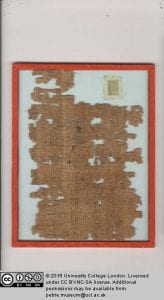Add Like an (Ancient) Egyptian
By uctzcbr, on 12 October 2017
As student engagers, we work in each of the museums no matter how far from our own disciplines they are. I study cybercrime which is not clearly related zoology, art, or Egyptology; as a result, I have received many looks of surprise from visitors when they discover someone working in the museum is not an expert in the subject matter. To be a better student engager, I have learned a lot about the history of each museum and researched many objects so that I can answer questions and provide useful information to visitors, but I also like to talk about subjects related to my discipline. For the Grant Museum, this means talking about a study which looked at the trade (or lack thereof) of endangered animal souvenirs on the Dark Net; for the Art Museum, I talk about an art exhibition displaying objects purchased at random from Dark Net Markets. However, I have always struggled to link my research to Archaeology and the objects at the Petrie.
Instead, I like to talk about my undergraduate degree: Mathematics. There is evidence that the Ancient Egyptians had not only a counting system but prolifically and pragmatically used Mathematics. Records show that they used maths for accounting, architecture, and astronomy, amongst other things. Their techniques enabled a complex tax system and were even adopted by Greek mathematicians such as Pythagoras.
However, Egyptian mathematics was very different to that which we use today. Whilst they also used a base 10 system, at first they only had symbols for the numbers 1, 10, 100, 1,000, 10,000 and 100,000. This made writing numbers sometimes laborious – to write the number 7, you would need to write the hieroglyph for the number 1 seven times. The numbers 2-9 were added later after they began writing on papyrus using the Hieratic script instead of Hieroglyphs. Fractions were denoted using a specific symbol and could only be of the form 1 , with a 1 as the numerator. This system made addition and subtraction simple but other tasks, such as multiplication, much more complex.
To do these more complex computations, the Ancient Egyptians would combine addition and subtraction in brute force methods that would provide approximations of the answer. For example, to multiply two numbers together, they would add the first number to itself the second number of times in a process of doubling not unlike the way computers are now programmed to do. As an illustration, to calculate 3 × 4 they would double 3 (that is 3 × 2) and then double 3 again (that is 3 ×(2+2)=3 ×4.
They would also rely on pre-calculated times tables to increase the speed of their work and prevent them from having to repeat the same problems again and again. This is believed to be the case because some of these tables have survived to today. For example, object UC32159 is a section of papyrus that displays division tables containing the answers to 2 being divided by the odd numbers from 3 to 31.
The collections in each of UCL’s museums are so large and varied that there will always be something relevant and of interest to anyone who visits.
 Close
Close



